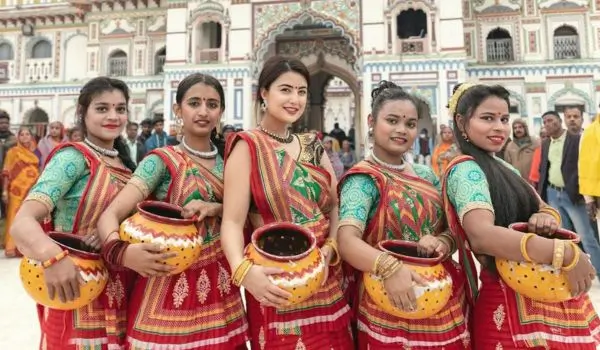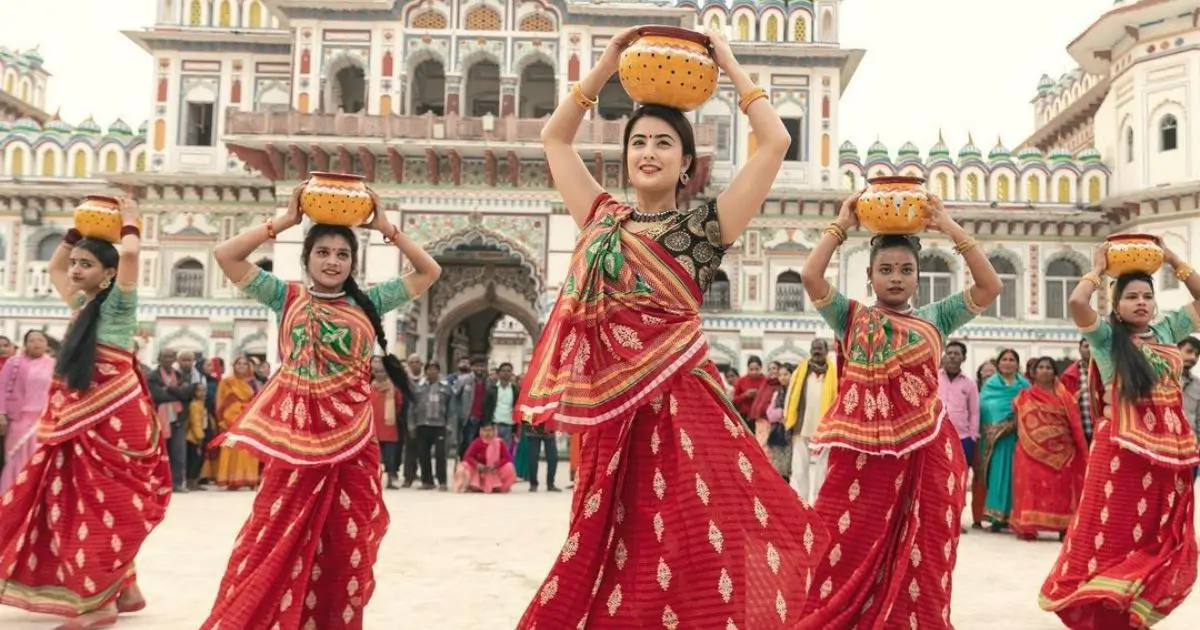In Mithila, the Jhijhiya dance is performed during the time of Dussehra and is dedicated to Durga Bhairavi (Mother Bhavani), the goddess of victory. The enthusiastic participation of girls characterizes the dance, and it holds a special place in the hearts of the people of this region.
As the crisp autumn air fills with the melodies of folk songs, virgin girls and women gather to perform this mesmerizing dance, each balancing a burning lamp within a pot adorned with meticulously crafted holes atop their heads.
This captivating spectacle unfolds during the auspicious Shardiya Navratri, a period when devotion and celebration are at their peak.
Page Index
A Dance of Harmony and Grace
The dance itself is a testament to harmony and grace. Women come together, forming a circle with their friends, and begin to dance while singing songs that resonate with centuries of tradition. In the center of this joyous circle stands the main dancer, the focal point of this mesmerizing performance.
What makes Jhijhiya truly remarkable is the skill and precision involved. Each dancer, including the central figure, carries a pot with hundreds of holes in her head, housing a lamp that casts a warm glow through the openings.
Another lamp adorns the lid of the pitcher. This dance is a symphony of movement, with everyone clapping, walking, and dancing in perfect synchronization. What’s truly astonishing is that these women perform this intricate dance without any support from their hands, all while gracefully carrying the pot with a lit lamp on their heads.
Prayers for Goodwill and Transformation
Jhijhiya is not merely a dance; it’s a powerful form of expression and a plea for change. Women use this folk dance as a platform to convey their concerns to the divine. Through the medium of song and dance, they lament the polluted mentality that plagues society, urging the deities to eradicate evil thoughts and usher in goodwill and positive thinking.
With the installation of the Kalash at the onset of Shardiya Navratri, this tradition commences, weaving its way into the fabric of the festival. It continues to evolve and culminates with the immersion of the idol of Maa Durga on Vijaya Dashami, marking a poignant end to this cultural spectacle.
A Plea for Abundant Harvests
In India, agriculture is not just a way of life; it’s a means of survival. The vagaries of the monsoon can either bless the land with a bountiful harvest or lead to famine.
In Bihar, the Hindu communities have a unique way of seeking the gods’ blessings for a prosperous harvest. These prayers are directed toward the Rain God Lord Indra, imploring them to send abundant rainfall for crops to flourish.
As part of these prayers, the ladies perform the Jhijhiya dance, intertwining it with their fervent pleas to protect their crops from scarcity and famine. They express gratitude for years of successful cultivation and seek continued blessings for fruitful harvests.
Intricate Lanterns and Graceful Movements

The Jhijhiya dance showcases not only the dedication and passion of its performers but also their impeccable training. These dancers execute their movements with effortless grace, a testament to their years of disciplined practice.
The highlight of this dance is the artfully designed lanterns made of mud, adorned with intricate holes. These lanterns are house lamps filled with oil or ghee, emitting a mesmerizing and gentle light that gracefully escapes through the perforations.
The sight of the dancers with lanterns atop their heads is a true spectacle. The precision with which they execute this dance leaves spectators in awe. Not a drop of oil is spilled, balance is maintained, and the performance is executed with the utmost professionalism.
Preserving Our Cultural Treasures
The Jhijhiya dance is a vivid example of the richness of Indian folk traditions. It showcases the dedication, talent, and artistry of the performers. While a few folk dances have garnered widespread recognition, countless others like Jhijhiya deserve greater appreciation.
It is time that we, as a society, recognize and celebrate these cultural treasures. Jhijhiya, with its harmonious melodies, graceful movements, and powerful messages, reminds us of the wealth of traditions that make up our cultural tapestry.
It serves as a call to action to ensure that our folk dances receive the recognition and acclaim they truly deserve.
Rhythms and Songs of Jhijhiya
Jhijhiya is not just a dance; it’s a symphony of songs and rhythms. Dancers move in graceful circles, singing the melodious Jhijhiya song. The accompaniment of folk instruments like Dhol and Manjira adds an enchanting layer to the performance.
The songs are of two distinct types: one dedicated to praising the Goddess, and the other invoked for protection against witches and the perils of black magic.
[Jhijhiya Song]
तोहरे भरोसे बरहम बाबा झिझिया बनैलियै हो
Jhijhiya song in Maithili language
बरहम बाबा झिझरी पर होईयऊ न असवार
A verse from the song Jhijhiya in the Maithili language is given below with English translation:
At your mercy, we follow Jhijhiya, Father Brahma!
Father Brahma, please come and be a part of this.
In conclusion, Jhijhiya dance transcends the boundaries of India and Nepal to become a cultural gem that embodies devotion, protection, and the age-old resilience of the people of Mithila.
As the earthen pots balance on the heads of the dancers and the songs fill the air, Jhijhiya stands as a testament to the enduring spirit of tradition and faith.
It is a captivating expression of cultural richness that continues to thrive in the modern world, reminding us of our shared heritage and the power of unity in the face of adversity.
Frequently Asked Questions (FAQs)
Q: What is Jhijhiya Dance, and where is it performed?
A: Jhijhiya also spelled Jhijhri, is a cultural folk dance native to the Mithila region of India and Nepal. It is primarily performed during the Dussehra festival, particularly in the Hindu month of Ashwin (September/October). This dance is a vibrant display of devotion to Goddess Durga and a means to protect against witches and black magic.
Q: Who participates in the Jhijhiya Dance?
A: Jhijhiya is predominantly performed by women and girls in groups ranging from five to fifteen. These participants are often virgin girls and women who carry earthen pots on their heads while dancing. Each pot contains a burning lamp and has several holes.
Q: What is the significance of the burning lamps in the pots?
A: The burning lamps within the pots are a central element of the Jhijhiya dance. They symbolize the light of devotion and protection. It is believed that if a witch can count the holes in the pot accurately, the dancer will face dire consequences, making the dance a powerful act of spiritual defense.
Q: Can you explain the origin myth associated with Jhijhiya?
A: According to legend, Jhijhiya’s origin is linked to the story of King Chitrasen, his wife Rani, and their nephew Balaruchi. The tale involves black magic, illness, and a quest for blood.
Balaruchi, after facing hardship, ultimately becomes the king’s successor, and tantric rituals are performed annually for his protection, a tradition later adopted by the people for the safety of their families.
Q: How is Jhijhiya performed during the Dussehra festival?
A: Jhijhiya is performed during the ten consecutive evenings from the day of Ghatasthapana until Vijaya Dashami. The dance begins with women forming a circle, and a main dancer often stands in the center.
All the dancers, including the main one, carry pots with numerous holes in their heads, each containing a lit lamp. The dance is characterized by clapping, walking, and dancing in perfect harmony.
Q: What messages are conveyed through Jhijhiya songs?
A: Jhijhiya songs serve as a medium for women to express their concerns about the polluted mentality prevalent in society. Through song and dance, they request divine intervention to eradicate evil thoughts and bring goodwill and positive thinking to society.
The tradition, which starts with the installation of the Kalash during Shardiya Navratri, culminates with the immersion of the Maa Durga idol on Vijaya Dashami.
Q: How does Jhijhiya relate to agriculture and prayers for a good harvest?
A: Jhijhiya is intertwined with prayers for a bountiful harvest, especially among tribal communities in Bihar. Since agriculture heavily relies on rainfall, these prayers are dedicated to the Rain God and Lord Indra, seeking their blessings for ample rainfall.
The Jhijhiya dance is performed as part of these prayers to ensure the prosperity of crops and prevent famine.
Q: Can you describe the lanterns used in the Jhijhiya dance?
A: The lanterns in the Jhijhiya dance are made of mud and feature intricate designs with carefully crafted holes. Lamps filled with oil or ghee are placed inside these lanterns.
The dance is a visual spectacle as the light gracefully escapes through the holes, creating a mesmerizing effect. Despite the intricate movements, the dancers maintain their balance and avoid spilling oil, showcasing their skill and professionalism.
Q: What efforts are needed to preserve and promote folk dances like Jhijhiya?
A: Preserving and promoting folk dances like Jhijhiya requires a concerted effort from both the community and authorities. This includes documenting and archiving traditions, providing opportunities for training and education, organizing cultural events, and raising awareness about the significance of these dances. Recognizing and celebrating the cultural richness of such dances is essential to their continued vitality.
Q: Besides Dussehra, are there any specific festivals or occasions when Jhijhiya is performed?
A: Jhijhiya is primarily associated with Dussehra, particularly during the Hindu month of Ashwin. However, variations and adaptations of the dance may be performed at other regional festivals or cultural events, showcasing the versatility and adaptability of this folk tradition.


